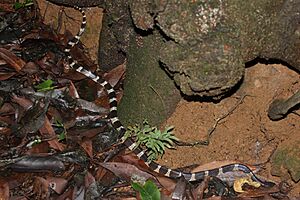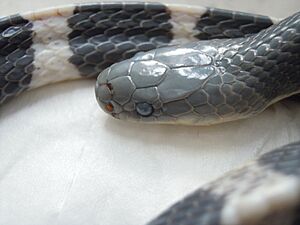Many-banded krait facts for kids
Quick facts for kids Many-banded krait |
|
|---|---|
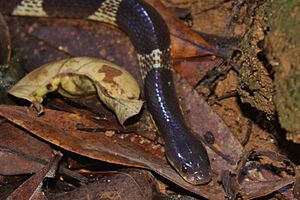 |
|
| Conservation status | |
| Scientific classification | |
| Genus: |
Bungarus
|
| Species: |
multicinctus
|
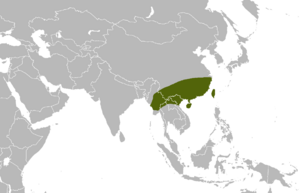 |
|
| Range of the many-banded krait | |
The many-banded krait (Bungarus multicinctus) is a very venomous snake. It is also known as the Taiwanese krait or Chinese krait. You can find this snake in central and southern China and parts of Southeast Asia. A scientist named Edward Blyth first described it in 1861.
This krait usually grows to be about 1 to 1.5 meters (3 to 5 feet) long. It has a black or bluish-black body with many white bands. It often lives in marshy areas, but can be found in other places too.
Contents
About the Many-banded Krait
What's in a Name?
The scientist Edward Blyth first described the many-banded krait in 1861. He noticed it had many more bands than another snake, the banded krait. So, he named it Bungarus multicinctus. The word Bungarus comes from a Telugu word for "krait." Multicinctus means "many-banded" in Latin.
The common name "krait" comes from the Hindi word "karait," which might mean "black."
Types of Many-banded Krait
There are two main types, or subspecies, of this snake:
- Bungarus multicinctus multicinctus
- Bungarus multicinctus wanghaotingi
The second type, Bungarus wanghaotingi, was described in 1928 by American herpetologist Clifford H. Pope. He named it after a zoological artist, Mr. Wang Hao-t'ing. This type is found in Myanmar and parts of China.
What Does it Look Like?
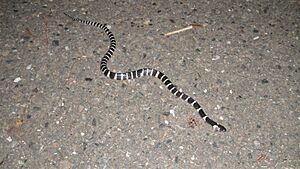
The many-banded krait is a medium to large snake. It is usually 1 to 1.5 meters (3 to 5 feet) long. Some can grow up to 1.85 meters (6 feet) long. Its body is slender and a bit flat on the sides.
Its scales are smooth and shiny. The snake is black or dark bluish-black with about 21 to 30 white or creamy white bands across its body. Longer snakes tend to have more bands. Its tail is short and pointed, also black with 7 to 11 white bands. The belly is usually white.
The head is mostly black, wide, and oval-shaped. It is slightly different from the body. The eyes are small and black, so the pupils are hard to see. This snake has large nostrils. Its fangs are small and fixed in the front of its upper jaw. Young kraits often have whitish spots under their heads.
Scales on the Body
Scientists use the number and arrangement of scales to identify different snake species. The many-banded krait has 15 rows of scales around the middle of its body. It has a single scale covering its vent (anal scale).
Male kraits have 200 to 231 belly scales and 43 to 54 scales under their tail. Females have 198 to 227 belly scales and 37 to 55 scales under their tail.
Where Do They Live?
This snake lives in Taiwan (including the Matsu and Kinmen islands), Hong Kong, Myanmar (Burma), Laos, and northern Vietnam. It might also be found in Thailand.
Many-banded kraits prefer humid, low-lying areas. They are often seen in subtropical, marshy regions. You can also find them in shrublands, woodlands, farm fields, and mangroves. They often live near water, like rivers, streams, rice paddies, and ditches. Sometimes, they even show up in villages and suburban areas. They can live in other habitats too, and have been found at elevations up to about 1,500 meters (4,900 feet).
Behaviour and Diet
This snake is nocturnal, meaning it is active at night. It can be more defensive in the dark. However, it is generally a shy and calm snake. During the day, it hides under rocks or in holes. These snakes usually come out in April and go into hibernation in November.
Unlike some other krait species that mainly eat other snakes, the many-banded krait mostly eats fish. But it also preys on other snakes, including its own kind. It also eats rodents, eels, frogs, and sometimes lizards.
Reproduction and Life Cycle
We don't have a lot of information about how these snakes reproduce. Like many snakes, many-banded kraits lay eggs. This is called being oviparous. Mating happens between August and September.
Females usually lay 3 to 15 eggs, but sometimes up to 20. They lay their eggs in late spring or early summer, usually in June. The eggs hatch about a month and a half later. The baby kraits are around 25 centimeters (10 inches) long when they hatch.
The longest a many-banded krait has lived in captivity is 13.7 years.
Venom and Its Effects
The venom of the many-banded krait is very strong. It contains special proteins called neurotoxins. These neurotoxins affect the nervous system, which controls muscles and breathing.
The average amount of venom a krait releases in one bite is about 4.6 to 19.4 milligrams. This venom is considered one of the most powerful among land snakes.
What Happens After a Bite?
If someone is bitten by a many-banded krait, the local area usually doesn't swell much or hurt a lot. The person might just feel a bit itchy and numb. However, more serious symptoms usually appear one to six hours after the bite.
These symptoms can include:
- Drooping eyelids (ptosis)
- Double vision (diplopia)
- Chest discomfort
- General aches
- Weakness in the limbs
- Difficulty walking (ataxia)
- Trouble speaking or losing voice
- Difficulty swallowing (dysphagia)
- Tunnel vision
- Trouble breathing
In very serious cases, breathing can stop, which can lead to death.
It's important to get medical help right away if someone is bitten by this snake. Sadly, American scientist Joseph Bruno Slowinski died in 2001 after being bitten by a juvenile many-banded krait in Myanmar.
Images for kids



